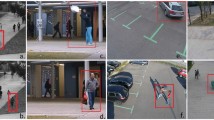Abstract
Pedestrian detection is one of the challenging tasks in the urban traffic environments. A natural urban traffic environments include different objects like buildings, vehicles, pedestrians and so on. The conventional approach only used for a particular traffic scenario and it does not suitable for different scenarios. A novel approach is required to model these traffic scenarios. Multiresolution Morlet Decomposition Based Iterative Learning Deformable Part Model (MMD-ILDP) is proposed for improving the performance of multiresolution pedestrian detection to control the traffic in the urban area with higher accuracy. The MMD-ILDP Model uses Morlet wavelet transformation for decomposing the image into subbands with multiple resolutions. After wavelet decomposition, histogram of oriented gradients (HOG) feature pyramid is generated. Then, feature matching is performed between the pedestrian objects in the image and the feature pyramid generated with HOG and the root and part scores are computed. Finally, the root and part scores are combined to compute the final score of objects in the image. The performance measures used in evaluating the proposed algorithm are detection accuracy, time and space complexity. The simulation results show that the MMD-ILDP Model gives improved pedestrian detection in urban traffic environment where healthcare systems find more difficult to reach to the people and also reduces the time complexity on detecting the pedestrians in road traffic scenes when compared to the existing DPM and RealBoost methods.




Similar content being viewed by others
References
Afrakhteh M, Miryong P (2017) Pedestrian detection with minimal false positives per color-thermal image. Arab J Sci Eng Springer 42(8):3207–3219
Biswas SK, Milanfar P (2017) Linear support tensor machine with LSK channels: pedestrian detection in thermal infrared images. IEEE Trans Image Process 26(9):4229–4242
Chen Y, Zhang L, Liu X, Chen C (2016) Pedestrian detection by learning a mixture mask model and its implementation. Inf Sci Elsevier 372(1):148–161
Choi HJ, Lee YS, Shim D-S, Lee CG, Choi KN (2016) Effective pedestrian detection using deformable part model based on human model. Int J Control Autom Syst Springer 14(6):1618–1625
Hong G-S, Kim B-G, Hwang Y-S, Kwon K-K (2016) Fast multi-feature pedestrian detection algorithm based on histogram of oriented gradient using discrete wavelet transform. Multimed Tools Appl Springer 75(23):15229–15245
Jiang X, Pang Y, Li X, Pan J (2016) Speed up deep neural network based pedestrian detection by sharing features across multi-scale models. Neurocomputing 185:163–170
Kim H-K, Kim D (2017) Robust pedestrian detection under deformation using simple boosted features. Image Vis Comput Elsevier 61:1–11
Kwak J-Y, Ko BC, Nam JY (2017) Pedestrian tracking using online boosted random ferns learning in far-infrared imagery for safe driving at night. IEEE Trans Intell Transp Syst 18(1):69–81
Li J, Gong W, Li W, Liu X (2010) Robust pedestrian detection in thermal infrared imagery using the wavelet transform. Infrared Phys Technol Elsevier 53:267–273
Li K, Wang X, Xu Y, Wang J (2016) Density enhancement-based long-range pedestrian detection using 3-D range data. IEEE Trans Intell Transp Syst 17(5):1368–1380
Li C, Wang X, Liu W (2017) Neural features for pedestrian detection. Neurocomputing, Elsevier 238:420–432
Liu Y, Lasang P, Siegel M, Sun Q (2016) Multi-sparse descriptor: a scale invariant feature for pedestrian detection. Neurocomputing, Elsevier 184:55–65
Luo Y, Yin D, Wang A, Wu W (2018) Pedestrian tracking in surveillance video based on modified CNN. Multimed Tools Appl 1–18
Maggiani L, Bourrasset C, Quinton J-C, Berry F, Sérot J (2016) Bio-inspired heterogeneous architecture for real-time pedestrian detection applications. J Real-Time Image Proc Springer 1–14
Ouyang W, Zeng X, Wang X (2016) Partial occlusion handling in pedestrian detection with a deep model. IEEE Trans Circuits Syst Video Technol 26(11):2123–2137
Ouyang W, Zeng X, Wang X (2016) Learning mutual visibility relationship for pedestrian detection with a deep model. Int J Comput Vis Springer 120(1):14–27
Paisitkriangkrai S, Shen C, van den Hengel A (2016) Pedestrian detection with spatially pooled features and structured ensemble learning. IEEE Trans Pattern Anal Mach Intell 38(6):1243–1257
Penn-Fudan Database: https://www.cis.upenn.edu/~jshi/ped_html/
Wang Y, Pierard S, Su S-Z, Jodoin P-M (2017) Improving pedestrian detection using motion-guided filtering. Pattern Recogn Lett Elsevier 96(1):106–112
Wei X, Lu W, Bao P, Xing W (2018) MGA for feature weight learning in SVM —a novel optimization method in pedestrian detection. Multimed Tools Appl Springer 77(7):9021–9037
Yan J, Zhang X, Lei Z, Liao S, Li SZ (2013) Robust multi-resolution pedestrian detection in traffic scenes. IEEE Conf Comput Vis Pattern Recognit (CVPR) 2013:3033–3040
Yang D, Zhang J, Xu S, Ge S, Hemantha Kumar G, Zhang X (2018) Real-time pedestrian detection via hierarchical convolutional feature. Multimed Tools Appl Springer 1–20
Zhang S, Klein DA, Bauckhage C, Cremers AB (2016) Fast moving pedestrian detection based on motion segmentation and new motion features. Multimed Tools Appl Springer 75(11):6263–6282
Zhang G, Jiang P, Matsumoto K, Yoshida M, Kita K (2017) An improvement of pedestrian detection method with multiple resolutions. J Comput Commun 5:102–116
Zhou Z-M, Zhao X (2016) Parallelized deformable part models with effective hypothesis pruning. Comput Vis Media Springer 2(3):245–256
Author information
Authors and Affiliations
Corresponding author
Additional information
Publisher’s Note
Springer Nature remains neutral with regard to jurisdictional claims in published maps and institutional affiliations.
Rights and permissions
About this article
Cite this article
Govardhan, S.D., Vasuki, A. Wavelet based iterative deformable part model for pedestrian detection. Multimed Tools Appl 79, 3667–3681 (2020). https://doi.org/10.1007/s11042-018-6435-1
Received:
Revised:
Accepted:
Published:
Issue Date:
DOI: https://doi.org/10.1007/s11042-018-6435-1




